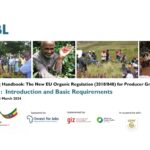
10 downloads
Title of document: Training Handbook: The New EU Organic Regulation (2018/848) for Producer Groups Authors/editor: Florentine Meinshausen (FiBL), Marlene Rudolph (Naturland), Toralf Richter (FiBL), Brian Ssebunya (Uganda), Abdi Itana (Ethiopia) Journal’s name if any: Ministry/Government Agency/Organization: EU Year of publication: 2024 Geographic focus: Main issues/ topics addressed (for example: Handbook…) School of agroecology (if any): Web address to original document (if any): https://www.fibl.org/en/shop-en/1270-eu-organic-regulation Summary: The training handbook was developed for organic producer groups to understand and apply the requirements of the new EU Organic Regulation. It represents FiBL’s status of understanding of the new EU regulatory requirements as per March 2024. Read More

35 downloads
Title of document: The World of Organic Agriculture Statistics & Emerging Trends 2024 Authors/editor: Helga Willer, Jan Trávníček and Bernhard Schlatter Journal’s name if any: Ministry/Government Agency/Organization: FiBL & IFOAM – ORGANICS INTERNATIONAL Year of publication: 2024 Geographic focus: Global level Main issues/ topics addressed (for example: Organic Agriculture Worldwide: Current Statistics; Global Market For Organic Food And Drink; Standards And Regulations Policy Support…) School of agroecology (if any): Web address to original document (if any): https://www.fibl.org/en/shop-en/1747-organic-world-2024 Summary: Organic agriculture is practised in 188 countries, and more than 96 million hectares of agricultural land are managed organically by at least 4.5 million farmers. Global sales of organic food and drink reached almost 135 billion euros in 2022. The 25th edition of "The World of Organic Agriculture", published by the Research Institute of Organic Agriculture FiBL and IFOAM – Organics International, offers a comprehensive review of recent developments in global organic agriculture. It presents detailed statistics on organic farming that relate to area under organic management, land use and crops, the number of farms and other operator types, retail sales and international trade data. The book includes contributions from representatives of the organic sector from around the world about the global market for organic food, organic imports, regulations and policies. It offers insights into current and emerging trends in organic agriculture in Africa, Asia, Europe, Latin America, North America, and Oceania and reports on several countries. Read More

11 downloads
Title of document: Agroecological initiatives in the Mekong Region: a systematic literature review and mapping reveals their implications for transitioning to sustainable food systems Authors/editor: Cornelia Hett, Zar Chi Aye, Christophe Gironde, Alice Beban, Jean-Christophe Castella, Rasso Bernhard & Albrecht Ehrensperger Journal’s name if any: Journal of Land Use Science Ministry/Government Agency/Organization: © 2023 The Author(s). Published by Informa UK Limited, trading as Taylor & Francis Group. Year of publication: 2023 Geographic focus: Mekong regional Main issues/ topics addressed (for example:) School of agroecology (if any): Web address to original document (if any): https://doi.org/10.1080/1747423X.2023.2248980 Summary: This article provides a comprehensive overview of agroecological initiatives in the region, including their geographical distribution, focus areas, and potential for scaling up. It also highlights some of the challenges and opportunities associated with transitioning to more sustainable food systems Read More
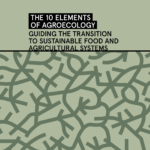
8 downloads
Title of document: The 10 Elements of Agroecology: Guiding the transition to sustainable food and agricultural systems Authors/editor: FAO Journal’s name if any: Ministry/Government Agency/Organization: FAO Year of publication: 2018 Geographic focus: Global Main issues/ topics addressed (for example:) School of agroecology (if any): Web address to original document (if any): Summary: Today’s food and agricultural systems have succeeded in supplying large volumes of food to global markets. However, high-external input, resource-intensive agricultural systems have caused massive deforestation, water scarcities, biodiversity loss, soil depletion and high levels of greenhouse gas emissions. Despite significant progress in recent times, hunger and extreme poverty persist as critical global challenges. Even where poverty has been reduced, pervasive inequalities remain, hindering poverty eradication. Integral to FAO’s Common Vision for Sustainable Food and Agriculture, agroecology is a key part of the global response to this climate of instability, offering a unique approach to meeting significant increases in our food needs of the future while ensuring no one is left behind. Agroecology is an integrated approach that simultaneously applies ecological and social concepts and principles to the design and management of food and agricultural systems. It seeks to optimize the interactions between plants, animals, humans and the environment while taking into consideration the social aspects that need to be addressed for a sustainable and fair food system. Agroecology is not a new invention. It can be identified in scientific literature since the 1920s, and has found expression in family farmers’ practices, in grassroots social movements for sustainability and the public policies of various countries around the world. More recently, agroecology has entered the discourse of international and UN institutions. Read More
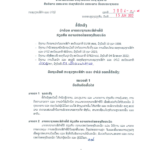
12 downloads
Title of document: Agreement of the Minister on Good Agriculture Practices for Agriculture Products Standard in Lao PDR [Lao Version] Authors/editor: DOA Journal’s name if any: Ministry/Government Agency/Organization: MAF Year of publication: 2022 Geographic focus: Lao PDR Main issues/ topics addressed (for example: New Agreement of the Minister on Good Agriculture Practices for Agriculture Products Standard in Lao PDR) School of agroecology (if any): Web address to original document (if any): Summary: New agreement of the Ministry of Agriculture and Forestry on Good Agriculture Practices for Agriculture Products Standard in Lao PDR, No. 3004/MAF, date 15 June 2022. Read More
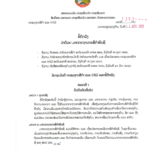
12 downloads
Title of document: Agreement of the Minister on Organic Agriculture Standards in Lao PDR [Lao Version] Authors/editor: DOA Journal’s name if any: Ministry/Government Agency/Organization: MAF Year of publication: 2022 Geographic focus: Lao PDR Main issues/ topics addressed (for example: new agreement of the Minister on Organic Agriculture Standards) School of agroecology (if any): Web address to original document (if any): Summary: New agreement of the Ministry of Agriculture and Forestry on Organic Agriculture Standards, No. 1393/MAF, date 11 April 2022. Read More
5 downloads
Title of document: Toward a sustainable food system and agroecology transition in Vietnam Authors/editor: The Anh Dao, Ngoc Mai Nguyen Journal’s name if any: VMOST Journal of Social Sciences and Humanities Ministry/Government Agency/Organization: VAAS Year of publication: 2023 Geographic focus: Vietnam Main issues/ topics addressed (for example: agroecology, food system, sustainable, Vietnam) School of agroecology (if any): Web address to original document (if any): Summary: Vietnam seeks to accelerate agricultural restructuring and develop modernity-oriented agriculture, improve the resilience and adaptability of the agricultural sector against climate change, and align this sector with the processing industry, markets, export activities, and global value chains. Vietnam is also committed to transforming its food systems into green, sustainable, low-emission agriculture and agroecological production. Vietnam wishes to become a Food Innovation Hub of Asia and to achieve nutrition security in 2030. A National Action Plan for a sustainable food system will be built. Read More
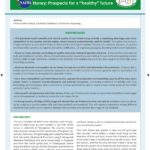
6 downloads
Title of document: Learning Brief- Marketing potential of Lao Forest Honey: Prospects for a “healthy” future_ English & Lao version Authors/editor: Emmanuelle Andaya, Soutsada Chanthasiri, Manivanh Aliyavong Journal’s name if any: Ministry/Government Agency/Organization: NAFRI, TABI, NUoL, GCDA, DECA, NTFP-EP Year of publication: 2018 Geographic focus: Lao PDR Main issues/ topics addressed (for example:…) School of agroecology (if any): Web address to original document (if any): Summary: NAFRI learning Brief: The perceived health benefits and natural quality of Lao Forest Honey provide a marketing advantage over other competitors in the country and the region, where honey is predominantly used for health. Strengthen Lao Honey’s image and brand as pure forest honey in the domestic and export markets through (1) a national standard, (2) quality and traceability systems, (3) hygiene and safety certification, (3) improved packaging, branding, and (4) communication. Focus on niche markets, competing on quality and value instead of quantity and price. Instead of the international bulk and traditional markets, the Lao Forest honey sector should focus on creating its own niche and capturing a share of the middle to high-end honey markets in the domestic and neighboring countries, and then expand to other high-value import ng countries. Increase domestic c consumption of Lao honey through accessibility and information dissemination. Improve distribution on systems and increase consumer awareness of the health benefits of honey in general, and the availability and quality of Lao honey to strengthen the domestic market. For a more competitive Lao Forest Honey Sector, upgrade the product and marketing capacity of the value chain actors, invest in research and development, and promote innovation. Combining traditional knowledge with new technology and techniques offers the potential to increase productivity and create unique honey products for health and other niche markets. Link up with entrepreneurs and other sectors. Make use of the tourism sector as a promoter on a platform and engage social entrepreneurs to further promote the Lao Honey Sector. A strong Country of Origin (COO) image will benefit the Lao Honey and other Lao natural products. Laos can develop its image as a country where safe and clean products are produced. This will require cooperation among different ministries and sectors and a national strategy that promotes and protects the image of Lao products. Read More
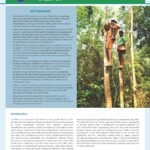
3 downloads
Title of document: NAFRI research Brief - Negotiating the Forest-Fallow Interface: Benzoin Tree in the Multifunctional Landscapes of Lao PDR Authors/editor: TABI Journal’s name if any: Ministry/Government Agency/Organization: NAFRI, TABI Year of publication: 2019 Geographic focus: Lao PDR Main issues/ topics addressed (for example:…) School of agroecology (if any): Web address to original document (if any): Summary: Research Brief No. 001/2019: Upland agriculture systems are under threat from competing land uses and development priorities that seek to intensify agricultural land uses while promoting strict forest conservation, leading to shortened fallow systems and a large-scale shift toward commodity crop production Better alternatives are needed for the development of Lao PDR’s uplands—alternatives that build on traditional management regimes, local agrobiodiversity and traditional knowledge systems rather than replace them, recognizing multiple uses of landscape systems and their substantial potential to contribute to sustainable socioeconomic development. Multifunctional landscapes depend on a complex mixture of croplands, forest, fallows and the diversity of endemic species used by local communities. Long-fallow rotational systems are a key element in these complex uplands, enhancing and supporting ecosystems services and the sustainability of upland systems Benzoin tree is exemplary of similar local species adapted to long-rotational cultivation systems and an integral part of upland diversity. Benzoin depends on long-fallowing and enhances economic returns from upland systems. Despite strong market demand and rising prices, Benzoin production has decreased dramatically in recent years due to shortening rotations and loss of available land due to forest conservation measures and the rapid expansion of commercial crops. Analysis indicates that for economic returns and production per unit of land and labour, benzoin production compares favourably with typical cash crop alternatives such as maize, while also delivering co-benefits for sustainability. Benzoin production represents an agro-forestry system with high sustainability. Benzoin should be regarded as an agricultural product, rather than a natural product with regard to quota systems and taxation. Read More

6 downloads
Title of document: NAFRI research Brief - New Directions for Participatory Land Use Planning: Can Bottom-up Approaches Achieve a Win-Win for Sustainable Development and Forest Conservation? Authors/editor: TABI Journal’s name if any: Ministry/Government Agency/Organization: NAFRI, DALaM, TABI Year of publication: 2019 Geographic focus: Lao PDR Main issues/ topics addressed (for example:…) School of agroecology (if any): Web address to original document (if any): Summary: Research Brief No. 002/2019: Land-intensive development pathways such as TLIC and the expansion of commercial agriculture are placing increased demand on rural landscapes and heightening tensions around resource-tenure security, requiring innovative approaches to planning. National development and conservation goals are sometimes, but not always, compatible with one another and with the needs and interest of local communities, requiring mechanisms for negotiation. Top-down planning tools provide a general framework for enhancing synergies and negotiating trade-offs between development and conservation goals at the macro-level, but bottom-up processes are necessary to ensure local needs and enable village-level planning and management. An innovative, bottom-up participatory land use planning approach co-developed and implemented by a consortium of GoL agencies, development practitioners and researchers through the Agro-biodiversity Initiative (TABI) demonstrates strong potential for supporting national development and conservation goals in a manner that is locally-acceptable and reflects actual land uses and resource needs. Through the participatory Forest and Land Use Planning and Management (pFALUPAM) approach, areas allocated for forests increased by 8.4 percent, though varied significantly by area depending on local contextual factors. Collaborative planning supported enhanced landscape-scale connectivity between forest areas, promoting ecosystem service values. Agrobiodiversity and the integrity of multifunctional landscapes were enhanced through zonation for local species and cultivars, protection of agricultural areas, and the promotion of long-fallowing in rotational upland systems through colocation. The pFALUPAM approach facilitated local management by clarifying inter-village boundaries to reduce conflict, enhancing local tenure security, and providing a mechanism for community consensus-building around management objectives. Further work is needed to support local institutions and capacities for adaptive management and the clarification of jap jong ti din1 and its effects on communally-managed resources. Read More

 Asia & Mekong Region
Asia & Mekong Region  Cambodia
Cambodia  Laos
Laos  Myanmar
Myanmar  Other
Other  Vietnam
Vietnam